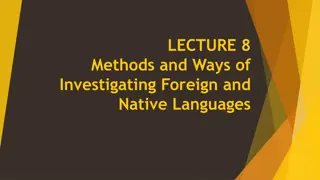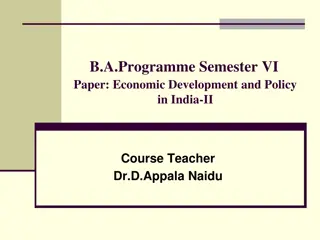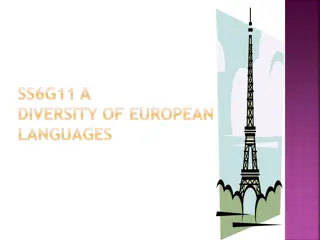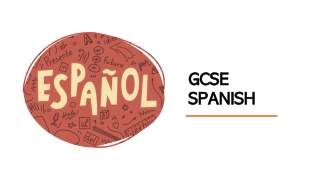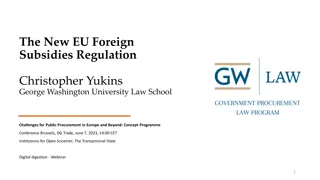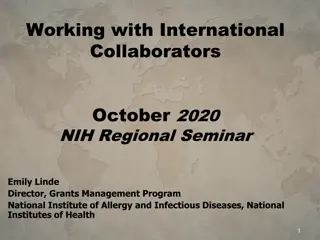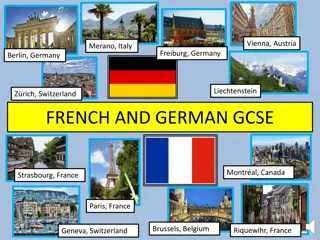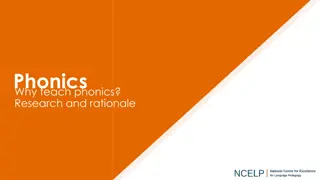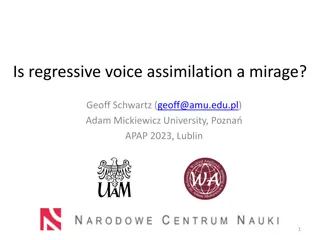Importance of Learning Foreign Languages in Education
Learning foreign languages should be compulsory for UK pupils up to the age of 16, according to a report by the Higher Education Policy Institute. The report highlights the decline in language proficiency among UK youth compared to their European peers and recommends reinstating compulsory language studies at key stages. It also suggests subsidizing language teaching at universities to ensure the diversity and cultural relevance of language education.
Download Presentation

Please find below an Image/Link to download the presentation.
The content on the website is provided AS IS for your information and personal use only. It may not be sold, licensed, or shared on other websites without obtaining consent from the author. Download presentation by click this link. If you encounter any issues during the download, it is possible that the publisher has removed the file from their server.
E N D
Presentation Transcript
Secondary Education Grade 10 English 102 New Language Leader Unit 7.4 STUDY AND WRITING SKILLS
Eng. 102 Unit 7 / Lesson 4 STUDY AND WRITING SKILLS OBJECTIVES By the end of the lesson, students will be able to: identify main ideas apply different types of note-taking study and analyze charts describe falls and increases write about a chart
What is note What is note- -taking? taking? How often do you practice note-taking? How useful is note-taking? Note-taking is the process of writing down what people are saying, what a journalist is observing, or simply what you are reading. By taking notes, the writer records the essence of the information, freeing their mind from having to recall everything. Eng. 102 Unit 7 / Lesson 4 STUDY AND WRITING SKILLS
What is note What is note- -taking? taking? You are going to read a quite long text which talks about learning foreign languages in Britain. First, we will together try to understand the text. Then we will try to practice note-taking depending on what we are looking for in that text. Therefore, try first to read the text and answer the questions. Eng. 102 Unit 7 / Lesson 4 STUDY AND WRITING SKILLS
LEARNING FOREIGN LANGUAGES SHOULD BE COMPULSORY, SAYS REPORT 1- UK children are not that much interested in learning foreign languages. Can you justify this fact from the text? A. .. B. .. C. .. D. .. 2- What solutions does the report recommend? A. .. B. .. C. .. D. .. E. .. Eng. 102 Unit 7 / Lesson 4 STUDY AND WRITING SKILLS
LEARNING FOREIGN LANGUAGES SHOULD BE COMPULSORY, SAYS REPORT Learning a new language should be compulsory for pupils up to the age of 16, according to a new report highlighting the UK s recent abysmal record in encouraging young people to study languages other than English. The report published by the Higher Education Policy Institute (Hepi) cites an EU-wide survey showing that just 32% of young people in the UK say they are able to read or write in more than one language, compared with 79% of their peers in France and more than 90% in Germany. The report calls for the overturning of the government s 2004 decision to drop compulsory study of languages at key stage four when pupils take GCSE exams in England, Wales and Northern Ireland which has led to a steep decline in the numbers in England going on to study languages at colleges and universities. It also recommends that the government should start subsidising the teaching of languages at universities, in light of declining enrolments and growing vulnerability for lesser taught languages , for strategic and cultural reasons. It was a big mistake to scrap compulsory foreign languages at GCSE, said Megan Bowler, the report s author. Rather than continuing to present languages as not suitable for everyone, we need to include a broader range of pupils learning through a variety of qualifications geared to different needs. Given the shortage of language skills in the workforce, we should safeguard higher education language courses, particularly those involving less widely-taught languages, and prioritise extra-curricular language learning opportunities. Fewer than half of all pupils in England, Wales and Northern Ireland sit a GCSE foreign language exam, compared with three in four in 2002 when study was compulsory. The report notes that GCSE entries in German have fallen by 67% since 2002, while French entries have dropped by 62%. The British Academy said it supported the report s recommendations, which match many of its own concerns. With Brexit just around the corner, we need linguists more than ever. Languages are vital for effective trade, diplomacy and soft power, for social cohesion, social mobility, and educational attainment, all of which will be essential to the UK s future success, said Neil Kenny, languages lead at the British Academy. Nick Hillman, Hepi s director, said making foreign languages optional at GCSE was one of the worst education policy blunders in recent memory, and that reinstating them was a no-brainer . In terms of speaking foreign languages, the British have never been good. But now the level has gone from low to dire, Hillman said. Eng. 102 Unit 7 / Lesson 4 STUDY AND WRITING SKILLS
LEARNING FOREIGN LANGUAGES SHOULD BE COMPULSORY, SAYS REPORT 1- UK children are not that much interested in learning foreign languages. Can you justify this fact from the text? A. Just 32% of young people in the UK say they are able to read or write in more than one language, compared with 79% of their peers in France and more than 90% in Germany. B. Fewer than half of all pupils in England, Wales and Northern Ireland sit a GCSE foreign language exam. C. GCSE entries in German have fallen by 67% since 2002, while French entries have dropped by 62%. D. In terms of speaking foreign languages, the British have never been good. But now the level has gone from low to dire. 2- What solutions does the report recommend? A. Learning a new language should be compulsory for pupils up to the age of 16 B. The overturning of the government s 2004 decision to drop compulsory study of languages at key stage four when pupils take GCSE exams in England, Wales and Northern Ireland C. The government should start subsidising the teaching of languages at universities D. Rather than continuing to present languages as not suitable for everyone, we need to include a broader range of pupils learning through a variety of qualifications geared to different needs. E. We should safeguard higher education language courses, particularly those involving less widely-taught languages, and prioritise extra-curricular language learning opportunities. Eng. 102 Unit 7 / Lesson 4 STUDY AND WRITING SKILLS
NOTE-TAKING STYLES Major Topic Two of the most used styles in note-taking include (1) outlines and (2) mind-maps. Sub-topic 1 1- The outline: Sub-topic 2 This is for people who like simplicity. It s one of the easiest ways Sub-topic 3 to take notes, and comes pretty naturally to most people. Sub-topic 4 When taking your outline notes, you start by choosing a major topic which you want to cover. Beneath that main topic, you add PRACTICE: Read the previous text again and try to take notes about the possible solutions to encourage the British to learn foreign languages. some more in-depth sub-topics which explain or support your initial topic. Eng. 102 Unit 7 / Lesson 4 STUDY AND WRITING SKILLS
LEARNING FOREIGN LANGUAGES SHOULD BE COMPULSORY, SAYS REPORT Learning a new language should be compulsory for pupils up to the age of 16, according to a new report highlighting the UK s recent abysmal record in encouraging young people to study languages other than English. The report published by the Higher Education Policy Institute (Hepi) cites an EU-wide survey showing that just 32% of young people in the UK say they are able to read or write in more than one language, compared with 79% of their peers in France and more than 90% in Germany. The report calls for the overturning of the government s 2004 decision to drop compulsory study of languages at key stage four when pupils take GCSE exams in England, Wales and Northern Ireland which has led to a steep decline in the numbers in England going on to study languages at colleges and universities. It also recommends that the government should start subsidising the teaching of languages at universities, in light of declining enrolments and growing vulnerability for lesser taught languages , for strategic and cultural reasons. It was a big mistake to scrap compulsory foreign languages at GCSE, said Megan Bowler, the report s author. Rather than continuing to present languages as not suitable for everyone, we need to include a broader range of pupils learning through a variety of qualifications geared to different needs. Given the shortage of language skills in the workforce, we should safeguard higher education language courses, particularly those involving less widely-taught languages, and prioritise extra-curricular language learning opportunities. Fewer than half of all pupils in England, Wales and Northern Ireland sit a GCSE foreign language exam, compared with three in four in 2002 when study was compulsory. The report notes that GCSE entries in German have fallen by 67% since 2002, while French entries have dropped by 62%. The British Academy said it supported the report s recommendations, which match many of its own concerns. With Brexit just around the corner, we need linguists more than ever. Languages are vital for effective trade, diplomacy and soft power, for social cohesion, social mobility, and educational attainment, all of which will be essential to the UK s future success, said Neil Kenny, languages lead at the British Academy. Nick Hillman, Hepi s director, said making foreign languages optional at GCSE was one of the worst education policy blunders in recent memory, and that reinstating them was a no-brainer . In terms of speaking foreign languages, the British have never been good. But now the level has gone from low to dire, Hillman said. Eng. 102 Unit 7 / Lesson 4 STUDY AND WRITING SKILLS
NOTE-TAKING STYLES SUGGESTED ANSWERS 1- The outline Solutions to encourage the British to learn foreign languages: Learning a new language should be compulsory for pupils up to the age of 16 The overturning of the government s 2004 decision to drop compulsory study of languages at key stage four when pupils take GCSE exams in England, Wales and Northern Ireland The government should start subsidising the teaching of languages at universities Rather than continuing to present languages as not suitable for everyone, we need to include a broader range of pupils learning through a variety of qualifications geared to different needs. We should safeguard higher education language courses, particularly those involving less widely-taught languages, and prioritise extra-curricular language learning opportunities. PRACTICE: Read the previous text again and try to take notes about the possible solutions to encourage the British to learn foreign languages. Eng. 102 Unit 7 / Lesson 4 STUDY AND WRITING SKILLS
NOTE-TAKING STYLES In addition to outlines, mind-maps are also widely used in note-taking. 2- Mind-maps: The mind map is a great way of taking notes. They are often used to get a handle on how certain topics relate, or to go in depth with one particular idea. For instance, if you re attending a lecture or reading a text about global warming, you may start with that concept in the center and then draw circles of all the things that lead to this issue as the lecturer lists them, or as the text presents them. You should notice that you do not have to write full sentences when you fill in your mind-map. factories means of transport deforestation Global Warming fossil fuels pollution PRACTICE: Read the previous text again and try to take notes about facts that demonstrate that UK children are not that much interested in learning foreign languages. Eng. 102 Unit 7 / Lesson 4 STUDY AND WRITING SKILLS
SUGGESTED ANSWERS NOTE-TAKING STYLES 32% unable to read or write in more than one language Mind-maps: PRACTICE: Fewer than 50% pupils sit a GCSE foreign language exam Nick Hillman: The level has gone from low to dire. Read the previous text again and try to take notes about Facts showing low interest in learning foreign languages facts that demonstrate that UK children are not that much interested in learning foreign languages. French entries have dropped by 62% since 2002 GCSE entries in German have fallen by 67% since 2002 You should use a mind-map. Eng. 102 Unit 7 / Lesson 4 STUDY AND WRITING SKILLS
MORE PRACTICE MORE PRACTICE You are going to read the text which you have seen in Lesson 7.1. The text presents the findings of different research studies that have investigated the issue of crime in the UK. Try to take notes about the possible causes which have led to the upsurge in this phenomenon. You may use either of the note-taking styles we have seen (the outline or the mind-map). You should remember that there is no right or wrong style for note-taking. You can even combine different styles. Eng. 102 Unit 7 / Lesson 4 STUDY AND WRITING SKILLS
What causes crime? What causes crime? The past few weeks have seen the publication of three heavyweight academic studies of the causes of crime and social breakdown in Britain. The findings have been met with very different receptions. The first research study, Crime and Unemployment Despite Denials, suggested that the rise in crime over the past 20 years is very closely connected with the upsurge in mass unemployment. The work of David Dickinson, an economist writing for the Labour Institute for Public Policy Research, examined long-term trends in great detail and, among many other things, demonstrated the simple fact that most criminals are unemployed. The second study, Imprisoned Fathers and their Children: A Reflection on Two Decades of Research, by Gwyneth Boswell of the University of East Anglia, reported on the backgrounds of children who commit crimes. Again the picture was grim. After looking at 250 juveniles in prison or in care for the most serious crimes, Dr. Boswell found out that 40 per cent had been beaten and bullied before they turned to crime. The third study was the Massive Psychosocial Disorders in Young People published by Sir Michael Rutter of the Institute of Psychiatry at London University and Professor David Smith of Edinburgh University. Their findings were radically different. Forget about poverty and bullying, they seemed to say, the real causes of crimes, as forms of social and psychological disorders, were the decline in morals and upsurge in personal freedom and selfishness in the last few decades. It should come as no surprise that, of the three studies, it was the Rutter-Smith report that received all the attention from the British media. It was the one that challenged an idea that seems both natural and sensible to most of us: that need causes crime as well as greed. When people find that they are unable to afford necessities, or luxuries, they are more likely to be tempted to steal. Against this background, the evidence collected by Rutter-Smith clearly suggests that a country's morals determine whether it is a happy and safe place to live or not. Eng. 102 Unit 7 / Lesson 4 STUDY AND WRITING SKILLS
MORE PRACTICE MORE PRACTICE SUGGESTED ANSWERS Unemployment upsurge in personal freedom and selfishness Violence against children Causes of the upsurge in crimes in the UK decline in morals bullying Eng. 102 Unit 7 / Lesson 4 STUDY AND WRITING SKILLS
WRITING SKILLS WRITING SKILLS DESCRIBING BAR CHARTS DESCRIBING BAR CHARTS What is a bar chart? A bar chart displays information (data) by using rectangular bars of different heights. A bar chart has a vertical axis with numbers on it, and a horizontal axis showing values of something that has been investigated. Amount of Sugar in Certain Foods 33.2 35 30.3 28.9 30 25 21.4 Percent of Sugar 20 In the given example, the bar chart provides information about the amount of sugar in seven different foods. These amounts are presented in percentages. 15 11.8 9.2 8.8 10 5 The vertical axis shows values from 0 to 35. These values represent the percentage of sugar in the given foods. 0 Crackers Ice Cream Soda Ketchup Peanut Butter Chocolate Bar Chocolate Cake The horizontal axis, however, shows the percentage of sugar in each food. These percentages vary according to the food type, which accordingly allows us to analyze the different values and compare/contrast them. Eng. 102 Unit 7 / Lesson 4 STUDY AND WRITING SKILLS
DESCRIBING BAR CHARTS DESCRIBING BAR CHARTS Look carefully at the bar chart on the right and decide if the following statements are true or false. Amount of Sugar in Certain Foods STATEMENTS T F 33.2 35 30.3 28.9 1- The blue bars show the grams of sugar in the given foods. 30 25 21.4 Percent of Sugar 2- Peanut butter is the food which has the lowest amount of sugar. 20 15 11.8 9.2 8.8 3- Chocolate bars have the highest amount of sugar. 10 5 4- Ketchup and peanut butter are the two foods which have the lowest amount of sugar. 0 Crackers Ice Cream Soda Ketchup Peanut Butter Chocolate Bar Chocolate Cake 5- Ice cream has more sugar than soda. 6- Chocolate cake has less sugar than crackers. Eng. 102 Unit 7 / Lesson 4 STUDY AND WRITING SKILLS
DESCRIBING BAR CHARTS DESCRIBING BAR CHARTS SUGGESTED ANSWERS Look carefully at the bar chart on the right and decide if the following statements are true or false. Amount of Sugar in Certain Foods STATEMENTS T F 33.2 35 30.3 28.9 1- The blue bars show the grams of sugar in the given foods. 30 25 21.4 Percent of Sugar 2- Peanut butter is the food which has the lowest amount of sugar. 20 15 11.8 9.2 8.8 3- Chocolate bars have the highest amount of sugar. 10 5 4- Ketchup and peanut butter are the two foods which have the lowest amount of sugar. 0 Crackers Ice Cream Soda Ketchup Peanut Butter Chocolate Bar Chocolate Cake 5- Ice cream has more sugar than soda. 6- Chocolate cake has less sugar than crackers. Eng. 102 Unit 7 / Lesson 4 STUDY AND WRITING SKILLS
DESCRIBING BAR CHARTS DESCRIBING BAR CHARTS SUGGESTED ANSWERS STEPS INVOLVED IN DESCRIBING A BAR CHART: Amount of Sugar in Certain Foods STEP 1: Start by describing what the chart is about. EXAMPLE: The bar chart provides information about the amount of sugar found in seven different foods. STEP 2: Develop your paragraph by stating the information given by the bars; include numbers. EXAMPLE: According to the chart, the four foods with the highest amount of sugar are chocolate bars, chocolate cake, soda and ice cream. Sugar constitutes 33.2% of chocolate bars, 30.2% of chocolate cake, 28.9% of soda and 21.4% of ice cream. Compared to the previous foods, however, the presence of sugar in crackers, peanut butter and ketchup is relatively limited. Sugar accounts for 11.8% of crackers, 9.2% of peanut butter, and 8.8% of ketchup. 33.2 35 30.3 28.9 30 25 21.4 Percent of Sugar 20 15 11.8 9.2 8.8 10 5 0 Crackers Ice Cream Soda Ketchup Peanut Butter Chocolate Bar Chocolate Cake STEP 3: End the paragraph by stating a general conclusion. EXAMPLE: Overall, sugar is found at varying amounts in almost all foods. Therefore, it is very important to cut down our daily sugar intake to avoid any health complications with time. Eng. 102 Unit 7 / Lesson 4 STUDY AND WRITING SKILLS
DESCRIBING BAR CHARTS DESCRIBING BAR CHARTS SUGGESTED ANSWERS STEPS INVOLVED IN DESCRIBING A BAR CHART: This is how your final text would look like. Amount of Sugar in Certain Foods The bar chart provides information about the amount of sugar found in seven different foods. 33.2 35 30.3 28.9 30 According to the chart, the four foods with the highest amount of sugar are chocolate bars, chocolate cake, soda and ice cream. Sugar constitutes 33.2% of chocolate bars, 30.2% of chocolate cake, 28.9% of soda and 21.4% of ice cream. Compared to the previous foods, however, the presence of sugar in crackers, peanut butter and ketchup is relatively limited. Sugar accounts for 11.8% of crackers, 9.2% of peanut butter, and 8.8% of ketchup. 25 21.4 Percent of Sugar 20 15 11.8 9.2 8.8 10 5 0 Crackers Ice Cream Soda Ketchup Peanut Butter Chocolate Bar Chocolate Cake Overall, sugar is found at varying amounts in almost all foods. Therefore, it is very important to cut down our daily sugar intake to avoid any health complications with time. Eng. 102 Unit 7 / Lesson 4 STUDY AND WRITING SKILLS
DESCRIBING BAR CHARTS DESCRIBING BAR CHARTS SALES IN SOMELAND Fill in the gaps with words from the list. expenditure rose bar steadily trends than - According remained Overall - includes 60 50 1. This .. chart provides information about spending on smart TV sets and laptops in Someland. 2. The chart .. information between 2016 and 2020. 3. .. to the chart, there was an upward trend in spending on both items. 4. Spending on smart TV sets increased .. by $5 million each year. 5. People s total .. on these electronic devices rose dramatically in this period. 6. From 2016 to 2018 laptop sales .. level at $10 million. 7. Expenditure on laptops is still less .. on computers. 8. The total spending on these items .. from $40 million in 2016 to $95 million in 2020. 9. .., the sales of both these items grew clearly during the last four years, but the sales on laptops grew more quickly. 10. If these two .. continue, spending on laptops could surpass spending on smart TV sets in 2021. 40 Millions US Dollars 30 20 10 0 2016 2017 2018 2019 2020 Smart TV sets Laptops Eng. 102 Unit 7 / Lesson 4 STUDY AND WRITING SKILLS
DESCRIBING BAR CHARTS DESCRIBING BAR CHARTS SUGGESTED ANSWERS SALES IN SOMELAND Fill in the gaps with words from the list. expenditure rose bar steadily trends than - According remained Overall - includes 60 50 1. This bar chart provides information about spending on smart TV sets and laptops in Someland. 2. The chart includes information between 2016 and 2020. 3. According to the chart, there was an upward trend in spending on both items. 4. Spending on smart TV sets increased steadily by $5 million each year. 5. People s total expenditure on these electronic devices rose dramatically in this period. 6. From 2016 to 2018 laptop sales remained level at $10 million. 7. Expenditure on laptops is still less than on computers. 8. The total spending on these items rose from $40 million in 2016 to $95 million in 2020. 9. Overall, the sales of both these items grew clearly during the last four years, but the sales on laptops grew more quickly. 10. If these two trends continue, spending on laptops could surpass spending on smart TV sets in 2021. 40 Millions US Dollars 30 20 10 0 2016 2017 2018 2019 2020 Smart TV sets Laptops Eng. 102 Unit 7 / Lesson 4 STUDY AND WRITING SKILLS
THIS IS THE END OF THE LESSON. Eng. 102 Unit 7 / Lesson 4 STUDY AND WRITING SKILLS






